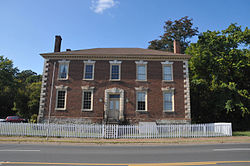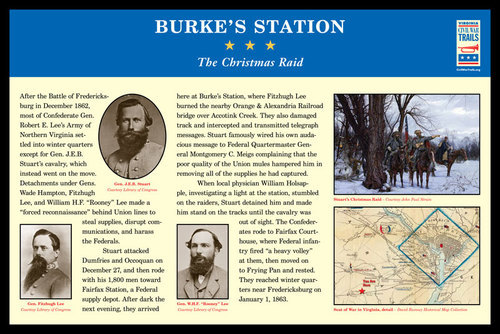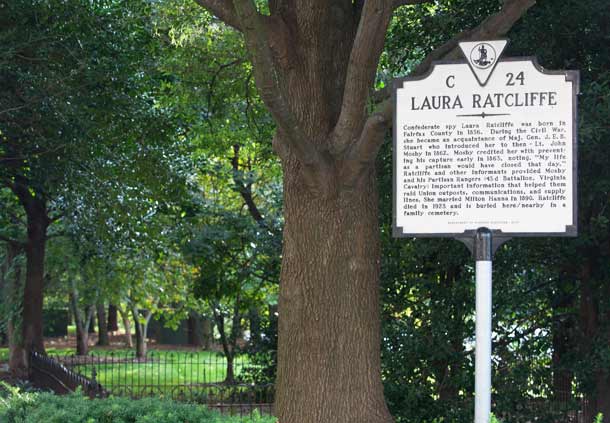ECW Weekender: JEB Stuart’s Christmas Raid
It is easy today to follow in the footsteps of JEB Stuarts cavalry on their 1862 Christmas Raid. The route is well known and there are several historic markers and Civil War Trail interpretive signs along the way to guide you.

The first stop should be at the Williams Ordinary in Dumfries (17674 Main St., Dumfries). The ca. 1760 tavern now serves as the administrative offices of the Prince William County Historic Preservation Division. Outside the Civil War Trails sign explains the Battle of Dumfries, which was the first of many skirmishes during the Christmas Raid. Here in Dumfries, the Union supply base was the target of Fitz and Rooney Lee’s cavalry while Wade Hampton’s wing continued northward towards Occoquan.

Moving northward your next stop should be the Mill House Museum in the Town of Occoquan (413 Mill St., Occoquan, VA). This early industrial town was a hot bed of pro-Lincoln sentiment. The Civil War Trails marker next to the museum describes the town’s Civil War history. Here Hampton flushed out Union cavalry on the night of December 28th. Several historic markers throughout town also explain the town’s history and its role in the Civil War. The fords used by Stuart’s cavalry are no longer accessible due to the Occoquan River being damned to create the Occoquan Reservoir. There are a few historic markers for both Selecman’s Ford and Wolf Run Shoals Ford on both sides of the Occoquan. The location of the Selecman’s Ford historic marker on the Prince William County side of the river is (38° 41.639? N, 77° 17.799? W) on Antietam Road.
After visiting Occoquan and the nearby historic markers, Burke will be your next stop. To get to the historic site of Burke Station drive to the intersection of Burke Road and Old Burke Lake Road, in Burke, VA. There are several historic markers in the vicinity explaining not just the Christmas Raid and Stuart’s famous telegram but also other Civil War history of the area. The white building at the intersection was once a train station on the Orange and Alexandria Railroad when the tracks ran through here (they are now a few hundred yards north).
 After Stuart telegraphed Meigs about his mules, he detailed Fitz Lee and twelve men to burn a large trestle bridge along the railroad over Accotink Creek. The location of railroad bridge is preserved at Lake Accotink Park (7500 Lake Accotink Park Rd., Springfield). The modern railroad runs over the creek at the same location on a modern bridge. At this location is a Civil War Trails marker and a Fairfax County historic marker detailing the Civil War history of the crucial railroad span.
After Stuart telegraphed Meigs about his mules, he detailed Fitz Lee and twelve men to burn a large trestle bridge along the railroad over Accotink Creek. The location of railroad bridge is preserved at Lake Accotink Park (7500 Lake Accotink Park Rd., Springfield). The modern railroad runs over the creek at the same location on a modern bridge. At this location is a Civil War Trails marker and a Fairfax County historic marker detailing the Civil War history of the crucial railroad span.
A well over-looked location in the area is the grave of Laura Ratcliffe. Ratcliffe was a confident and friend to many Confederate leaders including JEB Stuart and John S. Mosby. Her letters provide and a wonderful look into the personalities of both men and life in northern Virginia during the war. Her grave is located in the parking lot of the Dulles Marriott near the intersection of Centreville Rd and the Dulles Toll Road. The cemetery can be hard to find as it is over grown with shrubs. Just a mile south of her grave stands her home “Merrybrook,” now surrounded by development. 
The final stop is at Sully Historic Site (3650 Historic Sully Way, Chantilly). This ca. 1794 historic home was built by Richard Bland Lee, the uncle of Robert E. Lee. By the time of the Civil War the farm was the home to the Barlow and Haight families who emigrated from New York to Virginia in the 1830’s. Here, on their way westward, JEB Stuart, Fitz and Rooney Lee and Wade Hampton dined inside, much to the chagrin of the pro-Union lady of the house, Maria Barlow. The Confederates left their wounded in Barlow’s care and rode westward to Middleburg, then south across the Rappahannock River.
Reblogged this on Practically Historical.